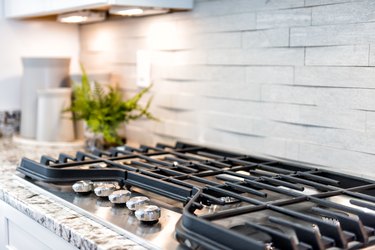
A rusty stove top isn't just an eyesore; it's a health hazard and can lead to accelerated wear and tear if left untreated. Removing rust on stoves can be accomplished physically, chemically or with a combination of the two approaches, with varying levels of collateral damage to surrounding surfaces' appearance and performance.
What Causes Rust on Stove Tops?
Video of the Day
Rust results from the chemical reaction between iron, water and oxygen. The water causes iron particles to bond with oxygen particles, resulting in portions of the iron surface converting to iron oxide. This process is one-way and causes "pitting" of the iron surface, which cannot be restored but must be ground or polished out to restore a smooth and level surface. The longer iron and water are allowed to interact, the deeper this pitting will reach into the iron, creating sharp corners hospitable to certain bacteria and potentially causing structural weaknesses.
Video of the Day
Steel is a highly processed iron with carbon elements throughout, resulting in harder material. In contrast, "stainless" steel includes chromium, which creates a protective layer of chromium oxide that prevents rust. Steel and stainless steel are susceptible to rusting, but the risk is less than regular iron. You could call stainless steel "stains less than usual" steel, as it still rusts if the protective layer is damaged. This damage allows water and oxygen to interact with the iron. If you notice rusting early and remove it with all three forms of iron, you limit the damage to imperceptibly small areas that are easily polished out.
Removing Rust From Cast Iron and Stainless Steel
Mild, also known as "black" iron, is rarely used in cooking applications since it rusts easily and is softer than cast iron or stainless steel, but the treatment process for any of them is mostly the same. One difference is that the protective layer of chromium oxide on stainless steel can be damaged by certain harsh chemicals, resulting in less rust protection after each cleaning. Cleaners containing chlorides, ammonia, alcohol or mineral spirits can damage stainless steel's protective coating.
While using steel wool or wire brushes to scrub away rust on stoves is very effective, it's a bad idea. These scouring materials scratch the surface below the rust and leave behind small particles of metal embedded in the scratches, which can encourage rusting in the future. A better alternative is using a mixture of heat, household chemicals and stiff-bristled plastic or natural-fiber brushes.
Steps for Removing Rust on Stoves
You can try applying a smooth paste of water and baking soda to the affected area to remove rust on stoves. Leave this mixture in place for at least an hour before gently scrubbing with the metal's grain to remove rust. Rinse using cold water and dry with a soft cloth. This process will remove most surface-level rust stains.
Potatoes naturally contain high amounts of oxalic acid, which breaks down iron oxide. If you cut a potato in half, sprinkle the cut surface with salt and apply a thin layer of mild dish soap, you can scrub off a surprising amount of rust. Sweet potatoes have almost twice as much oxalic acid as russet potatoes. You can also spray a mixture of one part distilled white vinegar and one part water onto rust to help dissolve it. This process allows you to gently scrub it off with a nonmetal scouring pad after only a few minutes.
Additional Notes and Cautions
If a single application of any of these methods doesn't remove rust stains, allow the surface to dry before trying it again. Avoid mixing multiple approaches without letting the surface dry between them to avoid unexpected chemical interactions. You can purchase other products for more concentrated chemical approaches.
Be sure to follow all manufacturer guidelines to avoid harming yourself or your stove top. Always scrub with the grain of the metal to avoid creating new scratches, and after cleaning cast iron surfaces, be sure to season them properly by applying extra virgin olive oil and heat.